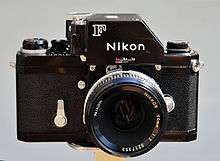System camera


A system camera is a camera with interchangeable components that constitutes the core of a system. Early representatives include Leica I Schraubgewinde (1930), Exakta (1936) and the Nikon F (1959). System cameras are often single-lens reflex (SLR) or twin-lens reflex (TLR) but can also be rangefinder cameras or, more recently, mirrorless interchangeable lens cameras.
Even point-and-shoot cameras usually include a tripod socket. A system camera includes at the very least a camera body and separate, interchangeable lenses, whence the alternative name interchangeable-lens camera (ILC). In addition it often includes:
- Electronic flash units matching the camera's capabilities.
- PC socket or tripod-adapter mounts for external flash units, rather than just a hot shoe
- Mechanical, electric, or IR/RF remote shutter release.
- Extensive supplementary equipment for macro photography and photomicrography.
- Adapters for third-party or legacy lenses, including tilt-shift adapters
- For film cameras, a motor drive to advance the film automatically.
- For film cameras, different camera backs, e.g. large capacity for bulk film, or data back or datebacks for recording exposure and date information.
- Add on correction or magnifying lenses to help focusing or composition through the viewfinder.
- Interchangeable viewfinders, including interchangeable focusing screens in the case of SLRs. Viewfinders and focusing screens could give different metering options.
- Extra-capacity battery packs, often in the form of a "battery grip" (a second, portrait-oriented handgrip), but also including fully external packs with cable interface
- AC adapters with dummy-battery interfaces for studio or other stationary work
- Sockets and matching cables for direct output, e.g., to a television
- Depth-of-field preview
- Global navigation satellite system receivers, e.g. (GPS) for geotagging
- Bluetooth or Wifi networking modules
While some early mechanical interfaces are standardized across brands, optical and electronic interfaces are often proprietary. Hot shoes have a common interface for basic flash functions, but often contain proprietary contacts inside for advanced flashes and data modules.